The AMD Radeon R9 290X Review
by Ryan Smith on October 24, 2013 12:01 AM EST- Posted in
- GPUs
- AMD
- Radeon
- Hawaii
- Radeon 200
Crysis 3
Still one of our most punishing benchmarks, Crysis 3 needs no introduction. With Crysis 3, Crytek has gone back to trying to kill computers and still holds “most punishing shooter” title in our benchmark suite. Only in a handful of setups can we even run Crysis 3 at its highest (Very High) settings, and that’s still without AA. Crysis 1 was an excellent template for the kind of performance required to drive games for the next few years, and Crysis 3 looks to be much the same for 2013.
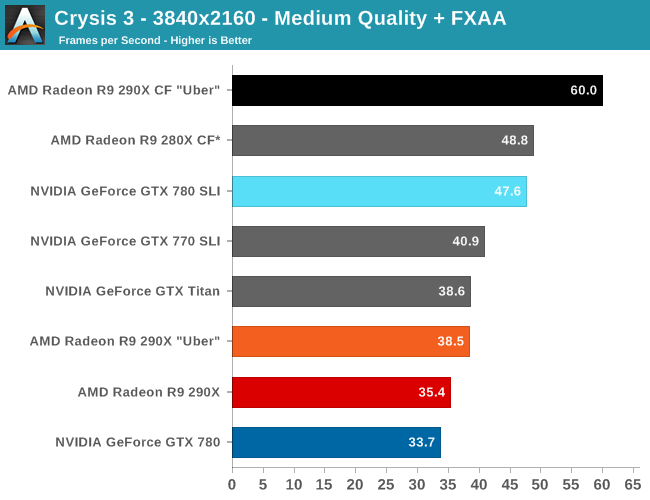
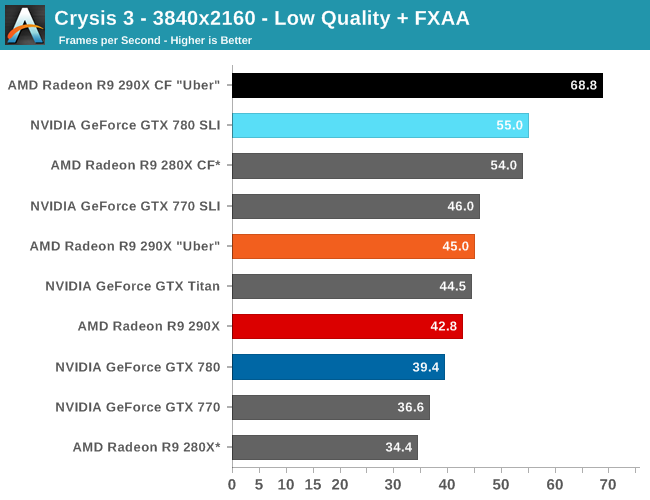
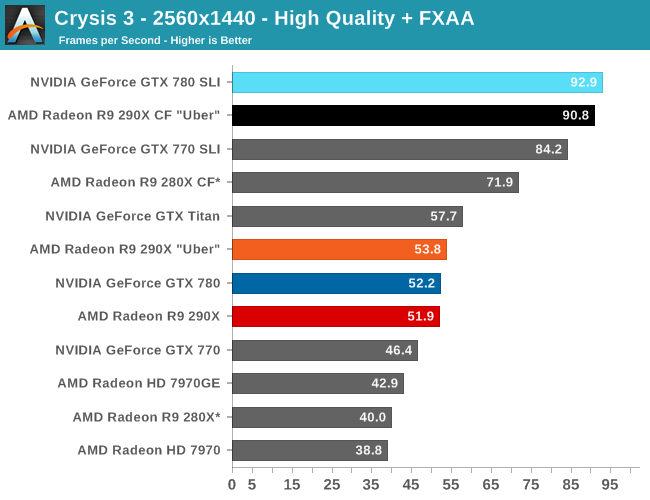

Much like Battlefield 3, at 2560 it’s a neck and neck race between the 290X and the GTX 780. At 52fps neither card stands apart, and in traditional Crysis fashion neither card is fast enough to pull off 60fps here – never mind the fact that we’re not even at the highest quality levels.
Meanwhile if we bump up the resolution to 4K, things get ugly, both in the literal and figurative senses. Even at the game’s lowest quality settings neither card can get out of the 40s, though as usual the 290X pulls ahead in performance at this resolution.
As such, for 60fps+ on Crysis 3 we’ll have to resort to AFR, which gives us some interesting results depending on which resolution we’re looking at. For 2560 it’s actually the GTX 780 SLI that pulls ahead, beating the 290X in scaling. However at 4K it’s the 290X CF that pulls ahead, enjoying a 53% scaling factor to the GTX 780’s 40%. Interestingly both cards see a reduction in scaling factors here versus 2560, despite the fact that both cards are having no problem reaching full utilization. Something about Crysis 3, most likely the sheer workload the game throws out at our GPUs, is really bogging things down at 4K. Though to AMD’s credit despite the poorer scaling factor at 4K the 290X CF in uber mode is just fast enough to hit 60fps at Medium quality, and not a frame more.
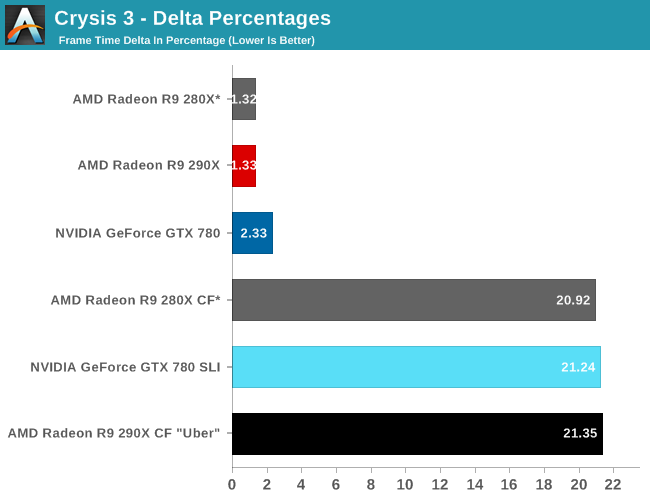
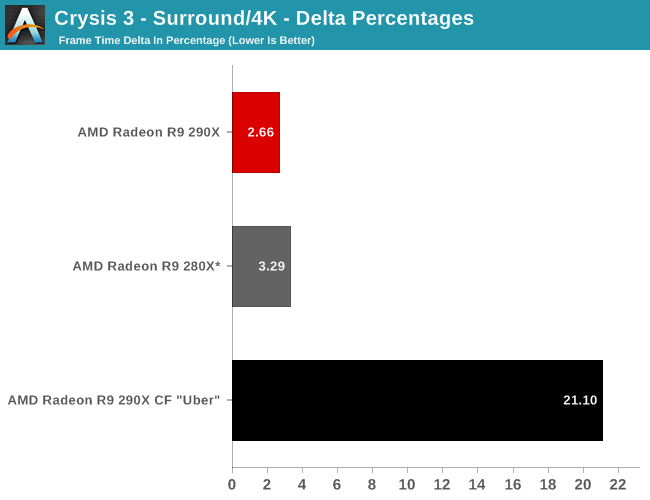
Moving on to our look at delta percentages, all of our AFR setups are acceptable here, but nothing is doing well. 20-21% variance is the order of the day, a far cry from the 1-2% variance of single card setups. This is one of those games where both vendors need to do their homework, as we’re going to be seeing a lot more of CryEngine 3 over the coming years.
As for 4K, things are no better but at least they’re no worse.


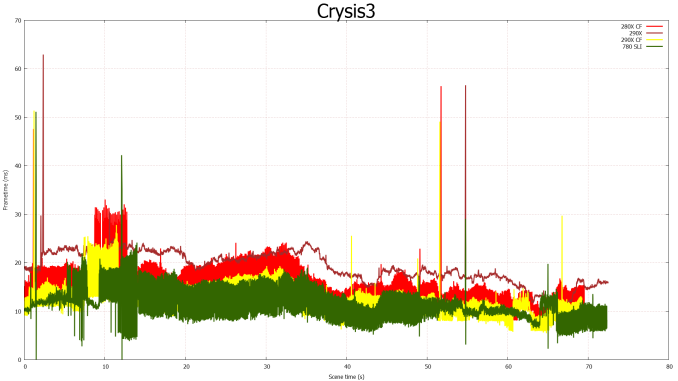
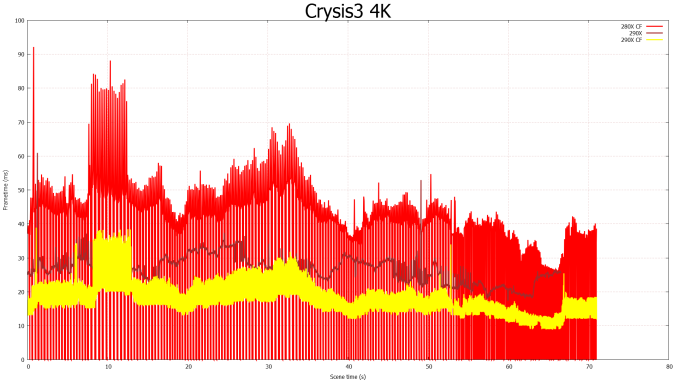








396 Comments
View All Comments
mr_tawan - Tuesday, November 5, 2013 - link
AMD card may suffer from loud cooler. Let's just hope that the OEM versions would be shipped with quieter coolers.1Angelreloaded - Monday, November 11, 2013 - link
I have to be Honest here, it is beast, in fact the only thing in my mind holding this back is lack of feature sets compared to NVidia, namely PhysX, to me this is a bit of a deal breaker compared for 150$ more the 780 Ti gives me that with lower TDP/and sound profile, as we are only able to so much pull from 1 120W breaker without tripping it and modification for some people is a deal breaker due to wear they live and all. Honestly What I really need to see from a site is 4k gaming at max, 1600p/1200p/1080p benchmarks with single cards as well as SLI/Crossfire to see how they scale against each other. To be clear as well a benchmark using Skyrim Modded to the gills in texture resolutions as well to fully see how the VRAM might effect the cards in future games from this next Gen era, where the Consoles can manage a higher texture resolution natively now, and ultimately this will affect PC performance when the standard was 1-2k texture resolutions now becomes double to 4k or even in a select few up to 8k depth. With a native 64 bit architecture as well you will be able to draw more system RAM into the equation where Skyrim can use a max of 3.5 before it dies with Maxwell coming out and a shared memory pool with a single core microprocessor on the die itself with Gsync for smoothness we might see an over engineered GPU card capable of much much more than we thought, ATI as well has their own ideas which will progress, I have a large feeling Hawaii is actually a reject of sorts because they have to compete with Maxwell and engineer more into the cards themselves.marceloviana - Monday, November 25, 2013 - link
I Just wondering why does this card came with 32Gb gddr5 and see only 4Gb. The PCB show 16 Elpida EDW2032BBBG (2G each). This amount of memory will help a lot in large scenes wit Vray-RT.Mat3 - Thursday, March 13, 2014 - link
I don't get it. It's supposed to have 11 compute units per shader engine, making 44 on the entire chip. But the 2nd picture says each shader engine can only have up to 9 compute units....?Mat3 - Thursday, March 13, 2014 - link
2nd picture on page three I mean.sanaris - Monday, April 14, 2014 - link
Who cares? This card was never meant to compute something.It supposed to be "cheap but decent".
Initially they made this ridiculous price, but now it is around 200-350 at ebay.
For $200 it worth its price, because it can be used only to play games.
Who wants to play games at medium quality (not the future ones), may prefer it.